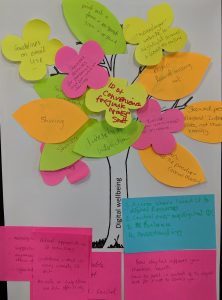Our work so far
Last year we revised our definition of digital wellbeing to broaden it and reflect how complex this area is. We also launched two briefing papers:
- One aimed at practitioners – it explores different aspects of digital wellbeing and includes actions that individuals can take to improve their digital wellbeing;
- One aimed at senior leaders – it explores good practice principles that organisations can adopt.
Personally, for me the most rewarding and (frankly most fun) part of this work was running workshops which looked at digital wellbeing in more detail. It was a real privilege to be able to share our work and learn how others see this area.
Workshop reflections
During the workshops the participants were asked to work on a series of questions building up an image of a digital wellbeing tree – what we hoped would be a nice wellbeing inducing activity in itself!
What is digital wellbeing?

We asked the participants to write down three top things that come to mind when they hear the term digital wellbeing. Here are some of the answers that came up:
- Being able to switch off digitally – good online/offline balance
- Awareness of the fact that we all exist in at least two realities – physical and digital
- Managing cyber safety, healthy interaction with technology/devices, digital footprint
- Controlling the impact of digital developments upon your personal identity
- Managing use of digital technology so that it positively not negatively impacts on personal wellbeing
- Strategies to stay mentally and physically healthy while using digital tools
- Self-awareness of how digital use makes you feel and behave
- Understanding how, when and why to use technology
What are the main challenges and solutions at organisational level?
One of the main challenges mentioned again and again is the expectation that staff can reply to emails at all times and are not able to turn off and disconnect. Some mentioned disconnect between formal definitions of digital wellbeing and actual digital practice. Senior management teams not seeing it as important was another challenge often quoted.
Some of the solutions around digital wellbeing issues at organisations mentioned by workshop participants were:
- Raising awareness across the organisation organisation
- Giving staff time slow down and time to learn tools
- Designing accessible systems – not just from a specific leading difficulty point of view; more of a case of needing to present a joined up approach
- Educating students regarding expectations of response times
- Ensuring there is adequate and proactive support through change involving digital systems – e.g. new ways of working (new systems, regular updates)
- Providing formal ‘breathing space’ in staff and student workloads, both to learn better practices and to ‘decompress’
What are your top tips for maintaining digital wellbeing?
During the last part of the workshop we spent some time asking participants to share their top tips for maintaining digital wellbeing. Not surprisingly there are a lot of suggestions just to switch off, have tech free day, do a digital detox and introduce more non-digital activities such as going for a walk or reading a book. Some tips around managing social media apps include “Unfollow anyone who doesn’t make you feel positive” or even deleting the apps and accessing them via web log-ins. One of the delegates made the following suggestion that sums up it all nicely: ‘’Take control of what you want to be part of in the digital world’’.
Get involved
We’d love to hear your views on the above via Twitter #digitalwellbeing or if you would like to discuss the topic of digital wellbeing further in a collaborative and fun way with colleagues across the sector then please join us at an upcoming workshop at Digifest on 11th March (10:30am session). You can also follow this work by subscribing to our new mailing list.
